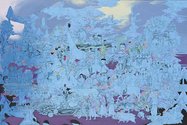Carmen Ansaldo – 14 December, 2015
What sets it apart is an apparent effort to scale back the theme-park feel of previous instalments to present an exhibition of clear thematic premise and curatorial vision. The first-time inclusion of Mongolia, Nepal, the Kyrgyz Republic and Georgia widens the geographic boundaries of its conceptual scope. These inclusions appease a developping expectation that each new APT installment will showcase a number of previously un-exhibited countries.
The Queensland Art Gallery/Gallery of Modern Art’s 8th Asia Pacific Triennial opened at the end of November to an audience of 32,000 people attending the weekend-long program of artist talks, films and performances. Over 80 artists are participating, representing an increasingly broad geographical and curatorial interpretation of the Asia-Pacific region, all responding to the theme of the body and performance.
Crystallising this theme into one cohesive large-scale exhibition across such a diverse region - while retaining other discourses inseparable from such a theme (sexuality, gender, history, culture, corporatisation and imperialism and so on) - is what makes the APT8 the most successful of the later blockbuster Triennial instalments. The selection of artists from 30 countries, made by a team of 15 national and international curators, ensures that this Triennial is no less momentous than its predecessors.
What sets it apart is an apparent effort to scale back the theme-park feel of previous instalments to present an exhibition of clear thematic premise and curatorial vision. The first-time inclusion of Mongolia, Nepal, the Kyrgyz Republic and Georgia widens the geographic boundaries of its conceptual scope. These inclusions appease a developping expectation that each new APT installment will showcase a number of previously un-exhibited countries. Fortunately, the poignancy and relevance of these most recent inclusions ensure that these new artists are not read as arbitrary selections, arousing interest purely through the unlikeliness of their inclusion.
The APT8 contains two smaller focus exhibitions within the wider Triennial: Yumi Danis (We Dance), a dance program that extends for the life of the exhibition and focuses on Papua New Guinea, Fiji, Solomon Islands, Vanuatu and New Caledonia; and Kalpa Vriksha, an exhibition located at the QAG site of contemporary Indigenous and Vernacular Art of India. Another notable curatorial emphasis is found in the strong focus placed on Australian representation, lending tangible weight to the curatorial team’s assertion that the Triennial functions as a conversation between the local and the global. This emphasis sees the inclusion of 17 Australian artists, of whom seven are Indigenous/First Nations people.
Less than a month after the official opening there has already been a strong indication of the audience’s favourites. All we leave behind are the memories (2015) by Indian artist Asim Waqif immediately comes to mind - a massive interactive installation that consumes GoMA’s entire ground floor entrance hall with arrangements of timber structures sourced from old residential and commercial buildings from around Brisbane. Waqif explores how the history of construction and demolition can hide or reveal aspects of local history. By rearranging found debris, he fabricates structures from materials that simultaneously function as a homage to their past usage, as well as a symbol of renewed possibility.
Anida Yoeu Ali’s video work and live performance The Buddhist Bug, Into the Night (2015) involves the artist suiting up in a giant orange caterpillar suit of variable dimensions, which she can extend or retract as she sees fit. Her opening weekend performances in this suit, throughout GoMA and its surrounds, echo the projections she has contributed to the exhibition where she explores the streets of Phnom Penh by cycle rickshaw wearing the same suit. Through her performance, Ali’s Brisbane audience is invited to embody the curiosity she makes apparent within her insect alter-ego. The Buddhist Bug, Into the Night is one of GoMA’s major new acquisitions and will no doubt go down in its history alongside Lee Wen’s Journey of a Yellow Man No. 13 (1999), both powerful performances sharing aesthetic and conceptual orientations.
Of course, there are many other standout artists exhibiting works on a more modest scale. Nepalese artist Tsherin Sherpa presents a series of paintings that deconstruct the traditional Tibetan tangka painting style he was originally taught by his father. Sherpa’s abstraction and dislocation of religious Tibetan icons, that hover over whirling vortexes, speak of the cultural dislodgement that has stemmed from his international relocation and the fragmented cultural identity that has followed.
Equally powerful are siren eun young jung’s four videos, Act of Affect (2013) and Lyrics I, II and III (2013). In these works, siren documents the rehearsal and performance of actors engaged in a style of Korean theatre called yeosong gukgeuk, an all-women musical drama popular from the forties to the sixties. Although yeosong is in decline, siren’s depiction powerfully and intimately captures the transferral of knowledge between the yeosong gukeuk actors, as well as their transformations into the male characters they portray.
From the Australian representation, Yirrkala artist Gunybi Ganambarr’s series of Larrakitj bulbous burial poles rendered in the labour-intensive cross-hatch of the Arnhem Land area is exceptional in its technical capacity and its expression of local cultural practices. Within the New Zealand contribution, the inclusion of Len Lye’s 1929 film Tusalava lends historical context to a lineage that finds its expression in the working practices of many Asian-Pacific contemporary new media artists. Tusalava was one of the first experimental films/kinetic art pieces from the Asia-Pacific region and consists of over 4000 drawings, taking Lye two years to create. The word ‘tusalava’ is Samoan in origin, referring to the process of everything coming full circle. Lye attempted to provoke a visceral reaction in the viewer through utilising film to privilege mind over matter in a fashion he (romantically) believed many Indigenous cultures of the Asia-Pacific region achieved within their respective cultural practices.
The APT8’s dedicated focus on performance and the body has meant that it is the first of the Triennial’s more spectacular, large-scale instalments to steer away from Eurocentric conceptualisations of a colourful yet mostly unchallenging ‘multiculturalism’. Accordingly, the works come closer to something that feels like a more equitable cultural exchange. As Gina Fairley identified in her ArtsHub review, ‘The word “urgency” was often uttered in conversations about these works over the opening weekend-the artists in APT8 very much responding to a deep global unease.’
I would agree that this sense of urgency is palpable, due to the intentional foregrounding of artists whose practices speak in no ambiguous terms of their immediate and international concerns. No artist shies away from this wider political discourse, and the consistent ability of all involved to articulate their concerns in thoughtful and conceptually rigorous ways, whilst maintaining a high level of aestheticism, has ensured the positive reception of the APT8 by the general public and the art industry alike. For these reasons the APT8 has proved to be an exhibition of notable maturity.
Carmine Ansaldo












 Two Rooms presents a program of residencies and projects
Two Rooms presents a program of residencies and projects Advertising in this column
Advertising in this column



This Discussion has 0 comments.
Comment
Participate
Register to Participate.
Sign in
Sign in to an existing account.